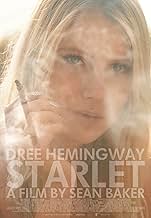Si forma un'improbabile amicizia tra la ventunenne Jane e l'anziana Sadie, dopo che Jane scopre una scorta di denaro nascosta all'interno di un oggetto alla svendita di Sadie.Si forma un'improbabile amicizia tra la ventunenne Jane e l'anziana Sadie, dopo che Jane scopre una scorta di denaro nascosta all'interno di un oggetto alla svendita di Sadie.Si forma un'improbabile amicizia tra la ventunenne Jane e l'anziana Sadie, dopo che Jane scopre una scorta di denaro nascosta all'interno di un oggetto alla svendita di Sadie.
- Regia
- Sceneggiatura
- Star
- Premi
- 6 vittorie e 6 candidature
Trama
Lo sapevi?
- QuizThe graphic sex scenes were filmed with porn star Zoe Voss, who acted as a double for Dree Hemingway.
- BlooperThroughout the film, Jane's green car changes back and forth from a Ford Probe to a Saturn.
- ConnessioniFeatured in The 2013 Film Independent Spirit Awards (2013)
- Colonne sonoreKeeps Coming Back
Written by Jonas Munk Jensen
Performed and produced by Manual
Published by Copyright Control copyright 2002 Morr Music
Courtesy of jens Alder, Morr Music
www.morrmusic.com
Recensione in evidenza
Twenty-one year old Jane (Dree Hemingway) is a porn actress simply trying to make ends meet in a cruel world, living with her two deadbeat roommates, one of them a fellow actress. After purchasing a vase from an older woman and finding over $10,000 inside, she decides that the least she could do is try and befriend the woman to provide some resemblance of joy and happiness in her life. I suppose friendship is the least you can offer someone after taking the money they didn't know they had.
The woman is eighty-five year old Sadie (Besedka Johnson), who spends her days calmly and in a true state of loneliness, tending her garden and quietly playing bingo at a senior's center. Meeting each other is a generational shock for the both of them in a way that doesn't revolve around the expected political/social norm changes. Instead, the details are shown just by the way they communicate and adapt to their own lifestyles accordingly. Jane would much rather go out of her way to get something more than textbook happiness, while Sadie feels disturbing consistent flow is a personal sin she can not commit.
Sean S. Baker's Starlet is a sweet, tender little story detailing a generation gap that I love to see explored. It's a film, too, that boldly shows a lifestyle in a way that isn't comical or condescending. While the adult film industry only makes up a small part of Starlet's overall focus, it nonetheless makes its view on the industry respectable and mature. The maturity of director Baker, even as he treads dangerously close to smug depiction, remains visible throughout making this a truly sentimental work.
The film is carried by the gifted performances of Hemingway and Johnson, who strike up a valuable, potent chemistry when they're on-screen together. Hemingway's brash qualities and aware attitude contrast boldly with Johnson's reclusive, control-freak persona, making for a relationship that is erected from more than smiles and good-feelings.
Baker adopts the style of filmmaking known simply as "cinéma vérité," a style that heavily emphasizes the brutally honest, naturalistic side of life in filmmaking. I mention it here because the texture and look of the film plays a big role in its likability. Visuals are often mild and possess a sunny disposition, the filmic atmosphere is accentuated beautifully through the use of lens flare and flushed-out colors, and the warmness comes off as not a put-on, but a comforting feature.
There are moments in Starlet that hold deep, uncompromising emotional drama, mainly in the scenes at bingo, where a coldly detached Sadie is left staring at her bingo card as if she really cares what the odds are. There's emotional honesty in the scene because we can see she is not really happy and Jane knows it as well as the audience does at that point. The scene is beautifully captured and scored perfectly so as not to be too mawkish or too downplayed.
Ultimately, Starlet ends the way we kind of expected and its presence is more significant than a footnote but not so much as a genre-piece or a game-changing masterwork. It's short, simple, but above all, an effective illustration of emotion and tone as a coming of age story and a slight meditation on age and its downsides. It provides warmth and heart in its material, but most importantly, an unmissable soul as it shows both generations in full bloom and the naive impulses they give off that often prevent entire personal connection.
Starring: Dree Hemingway and Besedka Johnson. Directed by Sean S. Baker.
The woman is eighty-five year old Sadie (Besedka Johnson), who spends her days calmly and in a true state of loneliness, tending her garden and quietly playing bingo at a senior's center. Meeting each other is a generational shock for the both of them in a way that doesn't revolve around the expected political/social norm changes. Instead, the details are shown just by the way they communicate and adapt to their own lifestyles accordingly. Jane would much rather go out of her way to get something more than textbook happiness, while Sadie feels disturbing consistent flow is a personal sin she can not commit.
Sean S. Baker's Starlet is a sweet, tender little story detailing a generation gap that I love to see explored. It's a film, too, that boldly shows a lifestyle in a way that isn't comical or condescending. While the adult film industry only makes up a small part of Starlet's overall focus, it nonetheless makes its view on the industry respectable and mature. The maturity of director Baker, even as he treads dangerously close to smug depiction, remains visible throughout making this a truly sentimental work.
The film is carried by the gifted performances of Hemingway and Johnson, who strike up a valuable, potent chemistry when they're on-screen together. Hemingway's brash qualities and aware attitude contrast boldly with Johnson's reclusive, control-freak persona, making for a relationship that is erected from more than smiles and good-feelings.
Baker adopts the style of filmmaking known simply as "cinéma vérité," a style that heavily emphasizes the brutally honest, naturalistic side of life in filmmaking. I mention it here because the texture and look of the film plays a big role in its likability. Visuals are often mild and possess a sunny disposition, the filmic atmosphere is accentuated beautifully through the use of lens flare and flushed-out colors, and the warmness comes off as not a put-on, but a comforting feature.
There are moments in Starlet that hold deep, uncompromising emotional drama, mainly in the scenes at bingo, where a coldly detached Sadie is left staring at her bingo card as if she really cares what the odds are. There's emotional honesty in the scene because we can see she is not really happy and Jane knows it as well as the audience does at that point. The scene is beautifully captured and scored perfectly so as not to be too mawkish or too downplayed.
Ultimately, Starlet ends the way we kind of expected and its presence is more significant than a footnote but not so much as a genre-piece or a game-changing masterwork. It's short, simple, but above all, an effective illustration of emotion and tone as a coming of age story and a slight meditation on age and its downsides. It provides warmth and heart in its material, but most importantly, an unmissable soul as it shows both generations in full bloom and the naive impulses they give off that often prevent entire personal connection.
Starring: Dree Hemingway and Besedka Johnson. Directed by Sean S. Baker.
- StevePulaski
- 14 mag 2013
- Permalink
I più visti
Accedi per valutare e creare un elenco di titoli salvati per ottenere consigli personalizzati
- How long is Starlet?Powered by Alexa
Dettagli
Botteghino
- Lordo Stati Uniti e Canada
- 88.212 USD
- Fine settimana di apertura Stati Uniti e Canada
- 15.662 USD
- 11 nov 2012
- Lordo in tutto il mondo
- 146.222 USD
- Tempo di esecuzione1 ora 43 minuti
- Colore
- Proporzioni
- 2.35 : 1
Contribuisci a questa pagina
Suggerisci una modifica o aggiungi i contenuti mancanti














